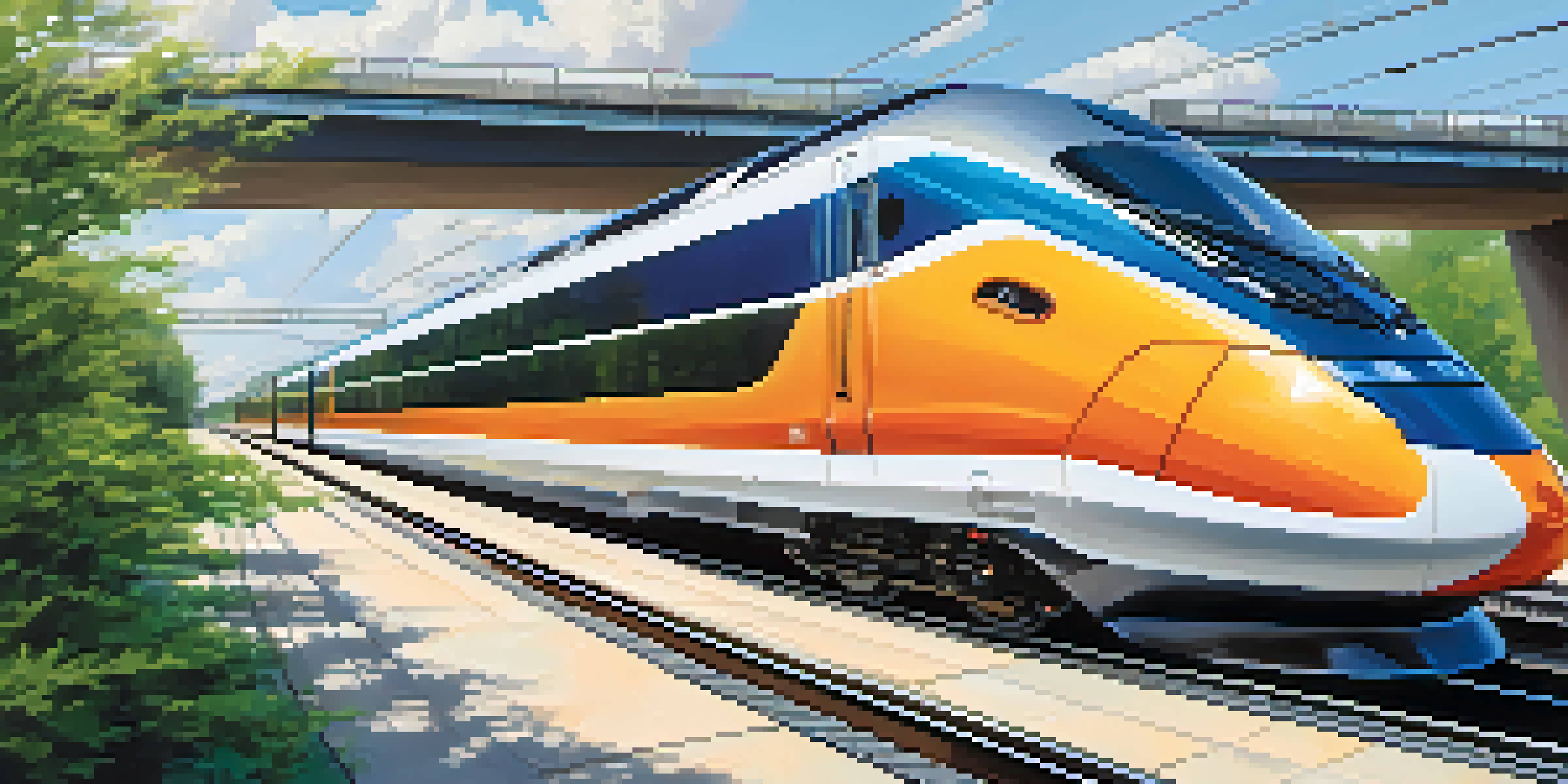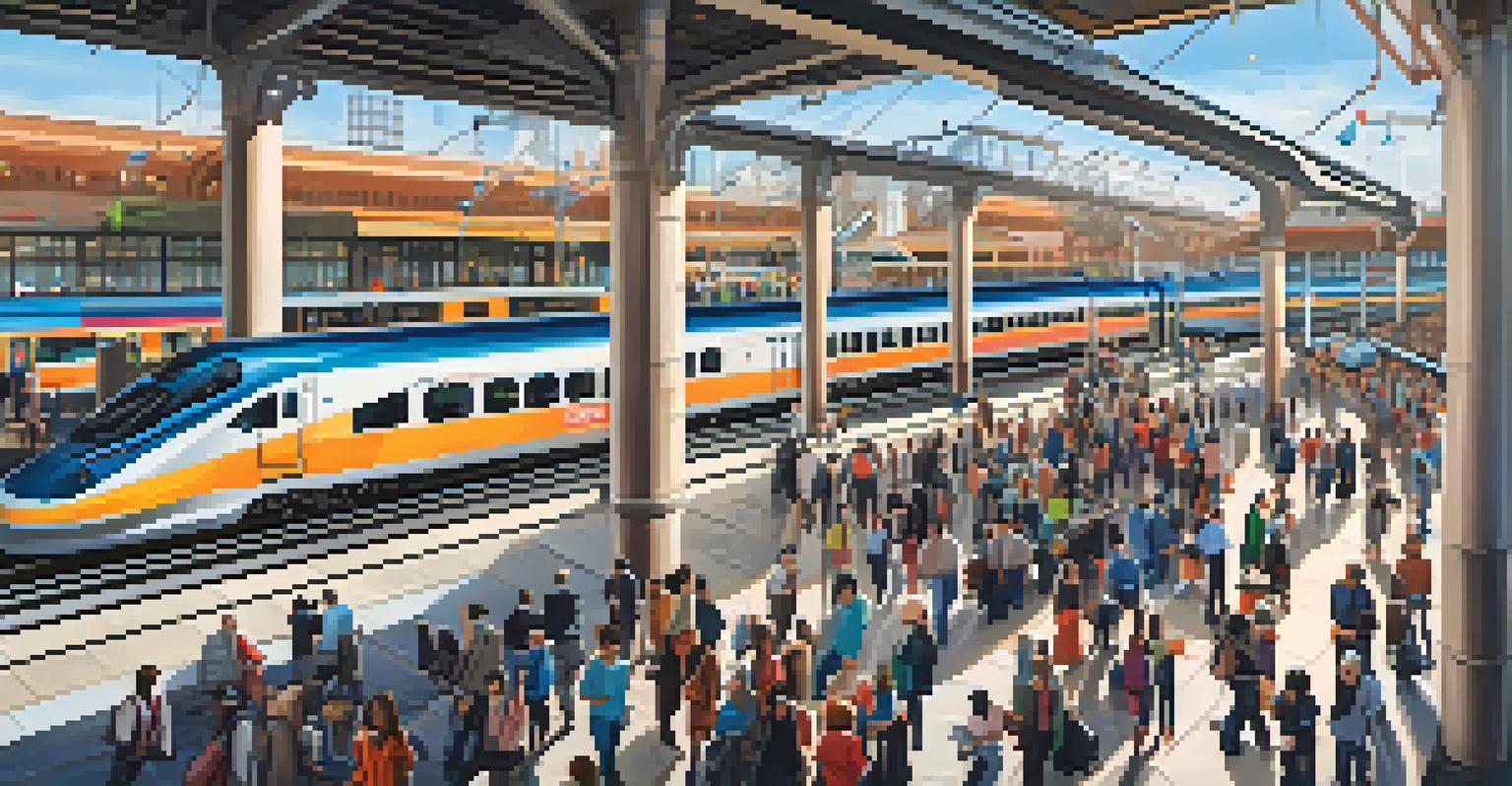High-Speed Rail Projects: Future of LA's Commuting Landscape

Understanding High-Speed Rail: A Quick Overview
High-speed rail (HSR) refers to trains that travel significantly faster than traditional trains, often exceeding speeds of 155 mph. This mode of transportation is designed to offer quicker, more efficient travel options between urban areas. In a sprawling city like Los Angeles, HSR presents a promising solution to tackle the notorious traffic congestion that residents face daily.
High-speed rail is a game changer for urban transportation, offering not just speed, but a sustainable alternative to road travel.
Imagine zipping from downtown LA to San Francisco in just a few hours, bypassing the stress of long drives or crowded flights. HSR aims to make this vision a reality, providing a seamless travel experience that combines speed with comfort. As cities across the globe continue to invest in high-speed rail, LA is positioned to join this transformative movement.
With advancements in technology and infrastructure, HSR projects are not just about speed; they also focus on sustainability. By reducing reliance on cars and planes, high-speed rail can lead to lower carbon emissions, making it a greener alternative for commuters.
Current High-Speed Rail Projects in Los Angeles
Currently, the most prominent high-speed rail project in California is the California High-Speed Rail (CHSR), which aims to connect major cities, including Los Angeles and San Francisco. The project has faced various challenges, from funding issues to construction delays, but it remains a critical component of California's transportation future. As segments of the rail line are completed, Angelenos can expect to see tangible benefits in their daily commutes.

One of the key features of the CHSR is its ability to integrate with existing transportation systems, creating a comprehensive network. For example, connections to local metro lines and bus services will make it easier for riders to access the high-speed rail stations. This seamless integration is crucial for encouraging more people to choose public transport over driving.
Economic Growth from HSR Development
The construction and operation of HSR are expected to create jobs and attract businesses, contributing to the economic revitalization of the region.
Moreover, there are plans for additional HSR lines that could further enhance connectivity within the region. By expanding the rail network, LA could see a significant reduction in traffic congestion, ultimately leading to a more efficient commuting landscape.
The Economic Impact of High-Speed Rail on LA
High-speed rail projects are not just about transportation; they also promise significant economic benefits for cities like Los Angeles. The construction and operation of HSR create jobs, from engineering and construction to service and maintenance roles. This job creation can boost local economies, providing residents with new opportunities and fostering economic growth throughout the region.
Investing in high-speed rail is investing in the future of our cities, connecting communities and boosting local economies.
Additionally, HSR is expected to attract businesses and tourism to areas surrounding the rail stations. As travel times decrease, visitors will find it easier to explore LA and its neighboring cities, increasing foot traffic and spending in local shops and restaurants. This influx can rejuvenate underdeveloped areas and promote urban revitalization.
Furthermore, the increased accessibility that HSR provides can lead to a rise in property values near stations. Homebuyers and investors are often drawn to locations with convenient transport options, making these neighborhoods more desirable. In this way, high-speed rail not only transforms commuting but also shapes the economic landscape of the region.
Environmental Benefits of High-Speed Rail in LA
One of the most compelling arguments for high-speed rail is its potential to significantly reduce carbon emissions. By providing a fast and efficient alternative to car travel, HSR can help lower the number of vehicles on the road, contributing to cleaner air and a healthier environment. As Los Angeles grapples with air quality issues, this aspect of HSR is particularly appealing.
Moreover, high-speed rail systems are typically designed with energy efficiency in mind. Many modern trains utilize electric power, which can be sourced from renewable energy, further minimizing their environmental footprint. By investing in HSR, LA can align itself with global sustainability goals and demonstrate leadership in combating climate change.
HSR Supports Environmental Goals
High-speed rail offers a sustainable alternative to car travel, potentially reducing carbon emissions and promoting healthier urban development.
In addition to reducing emissions, HSR promotes more sustainable urban development. By encouraging denser, transit-oriented development around rail stations, cities can create walkable neighborhoods that lessen the reliance on cars. This shift can lead to a more sustainable lifestyle for residents, benefiting both the environment and community health.
Challenges Facing High-Speed Rail Projects in LA
Despite the promising future of high-speed rail in Los Angeles, several challenges remain. One of the most significant hurdles is funding; high-speed rail projects require substantial financial investment and securing adequate funding can be a complex process. Delays in financing can push back project timelines, leaving commuters waiting for the benefits of HSR.
Additionally, there are concerns about the impact of construction on local communities. Many residents worry about noise, disruption, and the potential displacement caused by new rail lines. Addressing these concerns through effective communication and community engagement is vital to gaining public support for HSR initiatives.
Lastly, regulatory hurdles can slow progress on high-speed rail projects. Navigating the various levels of government and obtaining necessary approvals can be time-consuming. However, overcoming these obstacles is crucial for ensuring that Los Angeles can truly embrace the future of high-speed rail.
Public Opinion: How Angelenos View High-Speed Rail
The introduction of high-speed rail in Los Angeles has sparked a mix of excitement and skepticism among residents. Many people are eager for a solution to the city's notorious traffic jams and see HSR as a viable option. However, others remain cautious, questioning the project's feasibility and its potential impact on their neighborhoods.
Surveys indicate that while a substantial portion of the population supports high-speed rail, concerns about cost, construction disruptions, and environmental impacts persist. Engaging with the community through public forums and transparent communication can help address these issues and foster a more informed public discussion.
High-Speed Rail Enhances Connectivity
High-speed rail (HSR) in Los Angeles will significantly improve travel times and connect various transportation systems, making commuting more efficient.
Ultimately, public opinion will play a crucial role in shaping the future of high-speed rail in LA. As more information becomes available and projects progress, it's essential for stakeholders to listen to residents and incorporate their feedback into planning efforts.
The Future of Commuting in Los Angeles with HSR
Looking ahead, the implementation of high-speed rail is poised to revolutionize commuting in Los Angeles. With faster travel times and improved connectivity, residents will have more options at their fingertips, making it easier to navigate the sprawling city landscape. Imagine being able to hop on a train and reach your destination in a fraction of the time it currently takes.
In addition to improving daily commutes, HSR can encourage a cultural shift towards public transportation. As more Angelenos embrace the convenience of rail travel, it may also lead to a decline in car dependency, fostering a more sustainable lifestyle. This shift could ultimately lead to less crowded roads and a more vibrant urban environment.

As the vision of high-speed rail becomes a reality, it’s essential to continue prioritizing the needs of the community. By ensuring that HSR is accessible, affordable, and well-integrated with existing transport systems, Los Angeles can pave the way for a future where commuting is not just efficient, but also enjoyable.